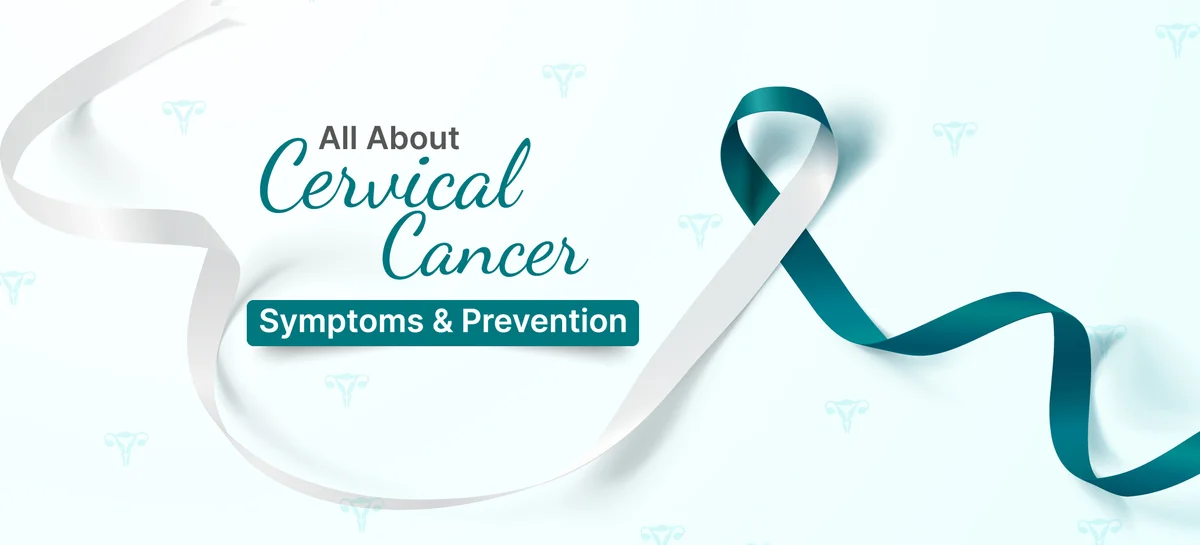- Home
- Blog
- Women Care
Cervical Cancer Guide 101: Symptoms, Screening and Prevention
Women Care
Cervical Cancer Guide 101: Symptoms, Screening and Prevention
By Apollo 24|7, Published on- 18 April 2023, Updated on -19 June 2023
Share this article
0
0 like

Cervical cancer is the 4th most common type of cancer detected in women globally. It usually begins in the cervix, which is a hollow cylindrical organ connecting a woman's vagina to the lower part of her uterus. In the majority of cervical cancer cases, the cells of the cervix start changing to precancerous cells. Though not all precancerous cells turn into cancer, it's vital to find these precancerous cells and treat them before they get a chance to mutate. Read on to learn more about the symptoms, risk factors, screening and prevention of cervical cancer.
Symptoms of Cervical Cancer
Many women suffering from cervical cancer don’t even realise they have cancer initially. This is because it doesn’t cause any symptoms until it reaches the late stages. When the symptoms do occur, they are often mistaken for urinary tract infections (UTIs) or menstruation. Some common symptoms of cervical cancer include:
- Pain in the pelvis
- Unusual bleeding, like after sex, between periods, or after menopause
- Frequent need to urinate
- Vaginal discharge that appears or smells unusual
- Pain during urination
It’s highly advisable to consult with your doctor immediately if you experience any of these symptoms.
Cervical Cancer Screening
Screening is used for detecting early cancers or precancerous changes before their symptoms appear. Innovation in medical and diagnostic science has led to the development of tools and tests that can help screen an individual for various kinds of cancer before the symptoms occur. Some of the procedures and tests that are used to detect cervical cancer include:
- Pap Test
Also referred to as pap smear, a pap test is the most common test done to detect early changes in the cells that can result in cervical cancer. This test involves getting a cell sample from the cervix. It is often performed during a regular gynaecological checkup.
- HPV Test
This test is performed on a cell sample taken from the cervix. This sample is tested to check for the strains of human papillomavirus (HPV) that are most commonly associated with cervical cancer. You can also collect the sample for your HPV test yourself.
- Visual Inspection with Acetic Acid (VIA)
This test involves the application of diluted white vinegar on the cervix. When exposed to vinegar, any abnormalities on the cervix turn white. This test must not be performed without the guidance of your healthcare provider.
Risk Factors for Cervical Cancer
The biggest risk factor for cervical cancer is HPV. However other factors that can also make you more susceptible to cervical cancer include:
- Obesity
- Smoking
- Family history of cervical cancer
- Intake of birth control pills
- A diet lacking fruits and veggies
- Pregnancy during teenage
- Three full-term pregnancies
- Chlamydia
- HIV
Having one or multiple risk factors does not guarantee cervical cancer. It just means that you should be more cautious and get yourself screened regularly.
How to Prevent Cervical Cancer?
There are a few steps you can take to reduce your risk of developing cervical cancer.
- The first and foremost step towards the prevention of this cancer is getting regular pap smears and gynaecological exams. This will help in detecting precancerous cells, allowing you to get them treated before they can turn cancerous.
- As HPV infection is the biggest risk factor for cervical cancer, focus on preventing it. This can be done by getting the HPV vaccine before an individual becomes sexually active. While cervical cancer is only a risk for women, both men and women can get HPV infections, which is why both should get vaccinated.
- Use condoms or some other barrier method of birth control during vaginal, anal, or oral sex.
- Stop using tobacco products and smoking. Cigarettes can make you more prone to not only cervical cancer but other forms of respiratory diseases.
Cervical cancer is quite common among women, irrespective of their age. So, it’s highly advisable to get regular screening tests done to prevent the development of this disease or to identify it early. If you have more questions,
Consult An Apollo Gynaecologist
Medically reviewed by Dr Sonia Bhatt.
Services
Women Care
Leave Comment
Services
Recommended for you

Women Care
Why Are Women More Prone To Fractures?
Most women experience a significant reduction in their bone density at or around menopause resulting in osteoporosis. Read more to know the other reasons.

Women Care
Can Hormone Therapy Help Treat Advanced-Stage Breast Cancer?
While treating cancer at an advanced stage can be difficult, this article shows the efficacy of hormone therapy against stage 4, metastatic breast cancer.

Women Care
7 Foods for Strong Bones and Joints in Women
Owing to women's higher susceptibility to osteoporosis than men's, it is essential for them to maintain good bone and joint health. This can be achieved by adding foods that are rich in nutrients like calcium, vitamin D and magnesium to the daily diet.
Subscribe
Sign up for our free Health Library Daily Newsletter
Get doctor-approved health tips, news, and more.

